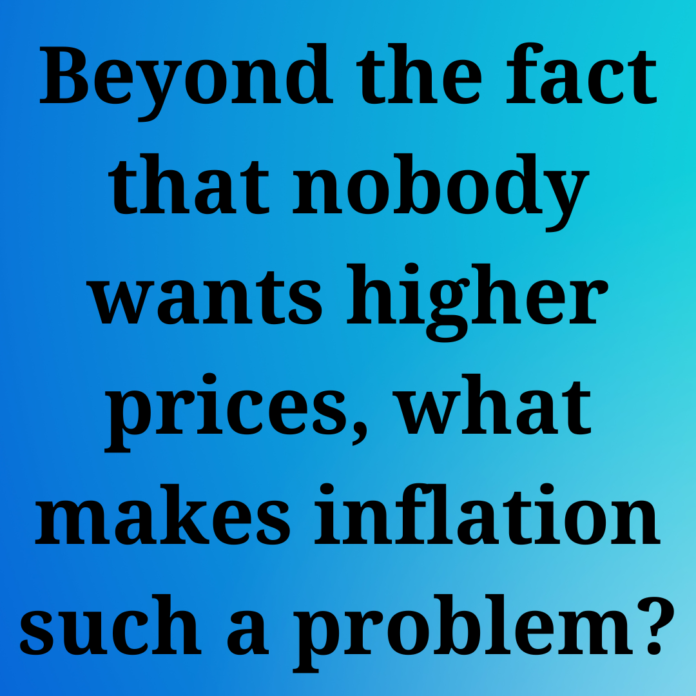by Chris Kuehl, managing director, Armada Corporate Intelligence
Remember grunge? Did you once sport a look featuring Doc Martens, dark flannel shirts and torn jeans while listening to Pearl Jam and Nirvana? If so, you are right in style for the return of 1990s economics. It has been almost 20 years since we have had to deal with anything approaching real inflation, and now it seems imminent. There are many people in business who have never encountered an inflation spike, but that experience may not be all that far away.
There are three pillars as far as inflation is concerned. At this point, one of the three generally is a total non-factor and nothing to be remotely worried about, but it could be affecting plastics; one already is making an aggressive push; and the third could be playing a major role by the end of the year. The plastics sector is feeling the pinch of inflation at all three levels, so the real questions are: How long will this threat last? and How bad will it get?
Pillar 1: Wage Inflation
The least economic impact felt thus far is in wage inflation, but that is a reference to overall employment and so is not all that descriptive as far as the industry is concerned. The massive employment meltdown due to the pandemic took the unemployment rate as high as 15% for a while, and a year later the rate still is high at just over 6.0%. Labor shortage has been an acute problem for many years – and this persistent shortage of qualified and trained workers has meant that higher wages and more generous benefits have been paid out to recruit the needed people and to keep them. The fact that millions of service sector workers lost their jobs due to COVID-19 did nothing to alleviate the labor shortage in manufacturing, construction, transportation and other skilled areas. The long and short of it is that many businesses have indeed seen wage inflation.
Pillar 2: Commodity Inflation
The second pillar of inflation has been abundantly obvious and has slammed the plastics sector extremely hard. The commodity inflation has been aggressive for months, and the prices keep getting higher. Oil prices languished in the $30 to $40 range for the first half of 2020, but that pattern started reversing even before the end of the year. Now prices are in the mid- to upper 60s consistently and have been as high as the 70s and even 80s. This ratchets up all the commodities that are linked to the oil sector. The higher prices arrived as demand started to make a recovery – and while many of the oil producers continued to reduce output. How high will the per barrel prices rise? The fact is that oil producers do not want to see prices much above that $80 range as this level of pricing invites marginal producers to get into the system, which tends to erode market share for the more dominant producers. The expectation is that prices will stay between $65 and $75 a barrel for the bulk of the year.
It is not just oil that has gone up. Most other commodities have been pushing new highs as well. Steel prices and other metal prices are up, as are prices for building materials, such as lumber. The costs of petrochemicals and resins have been rising right along with oil. These prices can be a lot more volatile as pricing often comes down to specific producers and refiners, and the Big Freeze in Texas had a very serious impact on refinery operations there.
For the most part, commodity-driven inflation is temporary as long as there is ample competition and as long as demand does not get carried away. There still is concern that demand will spike beyond what producers anticipate. The consumer has more than $5.4 trillion in savings, and that is close to a record. This is all money that can come off the sidelines in the months ahead, which could spark enough demand to overwhelm cautious suppliers.
Pillar 3: Monetary Supply
This brings us to the third pillar of inflation – that money supply. The fact that there is $5.4 trillion in consumer savings out there waiting to make an appearance is a good thing. It means people have the money to buy things, and polls suggest they have the desire. One of the prime barriers to that rush of spending has been the pandemic and, more specifically, the lockdowns that were implemented to control the spread. At the time of this writing, about 40% of the US population had been vaccinated – about 50% of adults and over 80% of seniors. This is not at herd immunity levels, but it has been enough for some states and communities to lift lockdowns – and that unlocks consumer spending.
Now the question is whether that unlocks too much and too fast. An abundance of cash cascading into the economy may overwhelm the ability of producers to meet demand, which could cause them to react by raising prices. This would dampen demand, but it is likely there will be consumers willing to pay the higher price.
The major boost to the money supply has come from the various stimulus efforts put forth by the government. Of those, the most important was in the second quarter of 2020. That was a deliberate stimulus attempt – a traditional recession-fighting tactic to get as much money in the hands of consumers as possible so they spend the economy out of recession. There was no attempt to target the funds – they were spread as widely as possible to all income levels so that everybody would spend. The problem is that consumers spend about 65% of their disposable income on services… and that outlet largely was denied them. Some switched and spent on goods, but most saved instead and that money is out there looking for a place to go.
The next potential boost comes from the latest stimulus and the potential spend on a big infrastructure effort. This stimulus was more of a rescue – targeted at those who had been adversely affected by the recession. It will add some to the consumer rush, but not as much as the first one. The infrastructure effort will be bogged down in congressional wrangling for months and will be unlikely to have an impact until 2022.
Beyond the fact that nobody wants higher prices, what makes inflation such a problem? The short answer is that higher inflation will provoke a reaction from the central banking community, which includes the Federal Reserve. The current rate range is between 0.0% and 0.25%, and the Cleveland Fed has issued a study that asserts the rate should be between 1.1% and 1.5%. That would involve at least four or five quarter-point hikes in the coming months. The Cleveland Fed is led by Loretta Mester, and she is a noted “hawk” as far as rates are concerned. Thus far, she is in the minority when it comes to hiking rates, and even she has suggested that inflation at the core level would not justify a rate hike at this point. The question is what level of inflation would be enough to trigger a rate hike and how high. For the time being, there is not a lot to worry about – but the next couple of quarters will bear watching.
Chris Kuehl is managing director of Armada Corporate Intelligence. Founded by Keith Prather and Chris Kuehl in January 2001, Armada began as a competitive intelligence firm, grounded in the discipline of gathering, analyzing and disseminating intelligence. Today, Armada executives function as trusted strategic advisers to business executives, merging fundamental roots in corporate intelligence gathering, economic forecasting and strategy development. Armada focuses on the market forces bearing down on organizations.
More information: www.armada-intel.com





